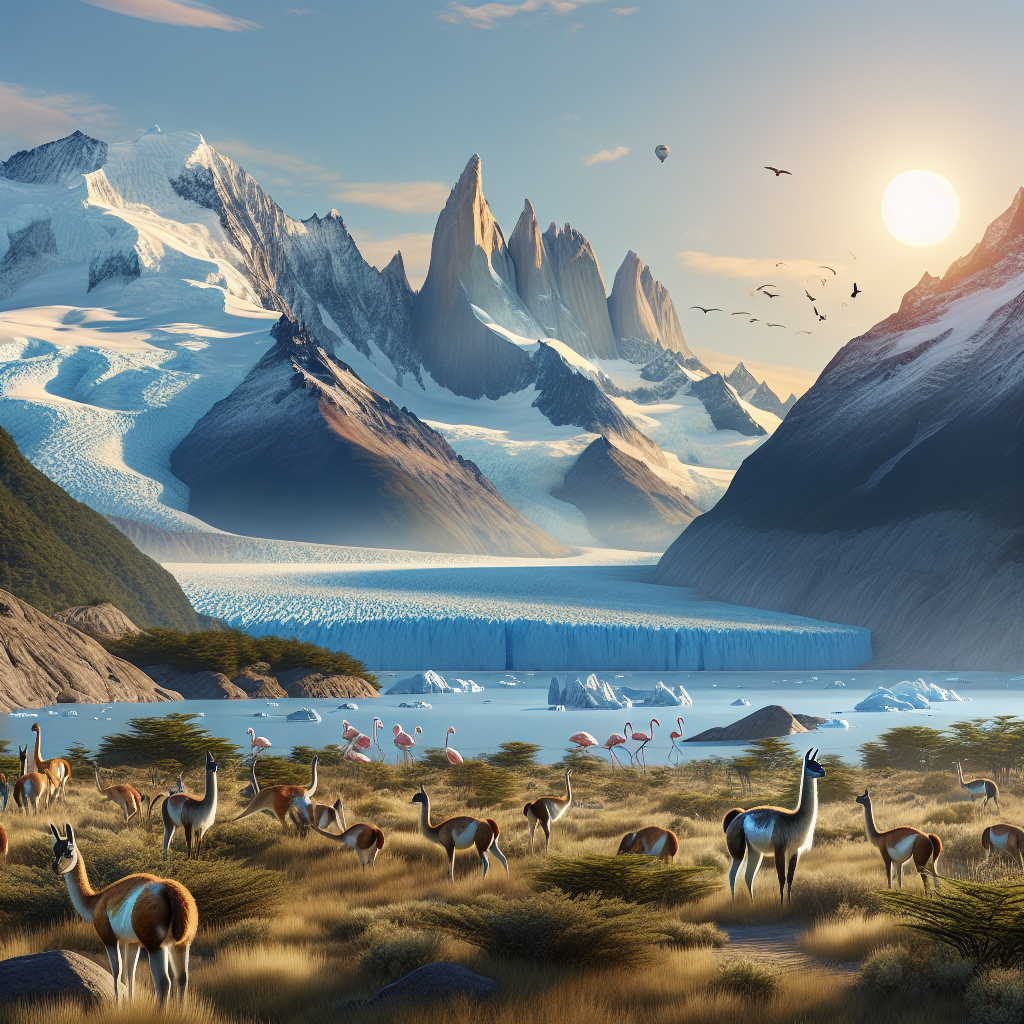Title: The Majestic Glaciers of Patagonia
Introduction
Patagonia, a region that spans the southern part of South America, shared by Argentina and Chile, is home to some of the most breathtaking and formidable natural landscapes on Earth. Among its many wonders are the renowned Patagonian glaciers, which captivate adventurers, scientists, and nature enthusiasts alike. These colossal ice formations reflect the intricate interplay of climate and geography over millennia, offering a window into the Earth’s climatic past and a harbinger of its future.
The Geographical Marvel: Patagonia
Patagonia is characterized by its vast steppes, deserts, and grasslands, but it is the Andes Mountains running along its spine that give birth to its most stunning feature: the glaciers. This region is host to the Patagonian Icefields, consisting of the Northern and Southern Patagonian Icefields. These are the largest ice masses in the Southern Hemisphere outside Antarctica, sprawling over thousands of square kilometers.
The Northern Patagonian Icefield is approximately 4,200 square kilometers, whereas the Southern Patagonian Icefield covers around 13,000 square kilometers. The glaciers descend from these icefields in colossal tongues of ice, flowing down the mountain slopes towards the fjords and lakes that mottled the landscape.
Formation and Dynamics of Patagonian Glaciers
Glaciers are formed from snow that compacts into ice over many years. In Patagonia, this process is influenced by the region’s climate, characterized by abundant snowfall in the Andes and relatively mild temperatures at lower altitudes. These conditions allow the glaciers to form and flow, though their behavior is subject to constant change due to climatic variations.
Patagonian glaciers are dynamic systems, advancing or retreating based on the balance between snow accumulation and ice melt. Most glaciers in Patagonia have been in a state of retreat over recent decades, driven by climate change. This retreat is a critical area of study, as it serves as an indicator of broader environmental shifts.
Notable Glaciers in Patagonia
-
Perito Moreno Glacier: Located in Los Glaciares National Park in the Argentine part of Patagonia, Perito Moreno is one of the most famous glaciers. It covers over 250 square kilometers and is unique in that it is one of the few glaciers worldwide that is still advancing. Visitors flock to witness its dramatic calving events, where chunks of ice the size of buildings break off and crash into the waters below.
-
Glacier Grey: Found in the Torres del Paine National Park in Chile, Glacier Grey is another striking ice mass. Stretching over 270 square kilometers, it is renowned for its brilliant blue ice and the icebergs that drift in the glacial lagoon in front of it. This glacier, like many others, is experiencing significant retreat due to rising global temperatures.
- Viedma Glacier: Also situated in Los Glaciares National Park, the Viedma Glacier is less visited but no less impressive. It is the largest glacier in Argentina and offers a raw and less crowded experience for adventurers eager to explore the rugged terrain and witness the power of nature.
The Importance of Patagonian Glaciers
The glaciers of Patagonia are not just picturesque attractions; they are crucial components of the region’s ecology and hydrology. These glaciers contribute to freshwater resources, feeding rivers and lakes essential for the habitats of various species and human communities. Moreover, they play a vital role in sea-level regulation, and their melt contributes to global sea-level rise.
Challenges and Conservation Efforts
The retreating glaciers in Patagonia are a stark reminder of the impacts of climate change. Increased temperatures lead to accelerated melting, threatening ecosystems and local livelihoods depending on glacial water. Protecting these glaciers involves addressing climate change at a global scale and implementing effective local conservation strategies.
In Patagonia, numerous protected areas and national parks have been established to safeguard the natural environment. Initiatives focus on sustainable tourism, reducing human impact, and promoting awareness about the importance of conserving these icy giants.
FAQs: Patagonyaʼda Buzullar (Glaciers in Patagonia)
-
What causes glaciers in Patagonia to retreat?
- Glaciers in Patagonia retreat mainly due to rising global temperatures, which increase the rate of ice melt while precipitation patterns shift, reducing snowfall that helps sustain them.
-
Is it possible to visit and walk on these glaciers?
- Yes, certain glaciers like Perito Moreno and Viedma offer guided trekking tours where visitors can explore the ice formations on foot. However, this must be done with experienced guides to ensure safety and minimize environmental impact.
-
What is calving, and why is it significant?
- Calving is the process where chunks of ice break off from the glacier’s edge and crash into the water. It is significant as it indicates the glacier’s dynamics and contributes to the formation of icebergs.
-
How do scientists study the Patagonian glaciers?
- Scientists study these glaciers using a combination of satellite imagery, field observations, and climate models to analyze their movement, melting rates, and impacts on global sea levels.
-
Are there any glaciers in Patagonia that are not retreating?
- The Perito Moreno Glacier is a notable exception; it is currently stable or slightly advancing, a phenomenon not fully understood but attributed to unique local climatic and geographical conditions.
- Can climate change mitigation efforts help save these glaciers?
- While individual mitigation efforts may have limited immediate impact, global action to reduce greenhouse gas emissions is crucial to slow down climate change and potentially stabilize the glaciers over time.
In summation, the glaciers of Patagonia are a testament to nature’s grandeur and fragility. While they continue to enchant visitors with their ethereal beauty and power, they also remind us of the pressing need to address environmental changes. Balancing exploration with conservation will ensure these natural treasures endure for generations to come.






